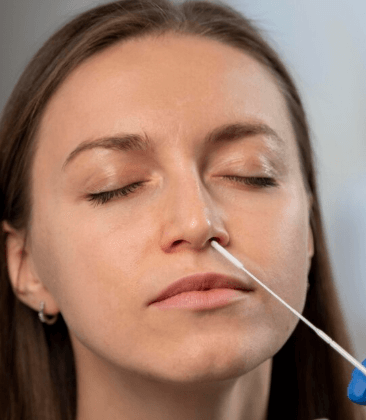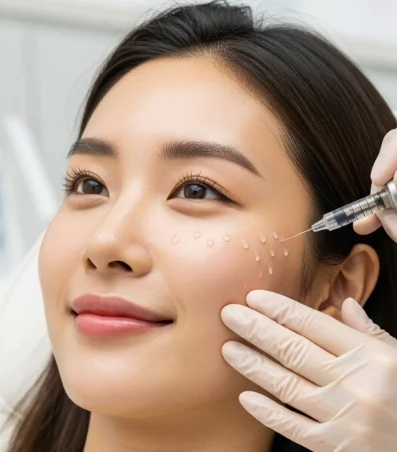Treatment Overview
Injectable Nose Bridge Augmentation in Korea is a popular non-surgical procedure designed to enhance the height, definition, and symmetry of the nasal bridge using hyaluronic acid (HA) fillers. Often referred to as a “liquid rhinoplasty,” this treatment provides a safe, quick, and reversible alternative to traditional surgical rhinoplasty, with minimal downtime.
Korean dermatology clinics are globally recognized for their expertise in filler-based nose augmentation. Specialists utilize advanced injection techniques, micro-cannulas, and precise facial mapping to create a natural, harmonious nose that complements each patient’s facial structure. This procedure is ideal for individuals seeking a refined, elevated nasal bridge without undergoing surgery.
Purpose & Benefits
The main goal of Injectable Nose Bridge Augmentation is to improve the appearance of the nasal bridge, enhancing overall facial balance and aesthetics. Benefits include:
- Enhanced Bridge Height: Adds definition to a flat or low nasal bridge.
- Corrects Asymmetry: Smooths minor irregularities and uneven contours.
- Non-Surgical Alternative: Avoids anesthesia, incisions, and extended recovery times.
- Quick Procedure: Typically completed within 30–45 minutes.
- Natural Results: Subtle enhancements maintain harmony with other facial features.
- Temporary and Reversible: HA fillers can be dissolved or adjusted if needed.
- Minimal Downtime: Patients can resume daily activities immediately.
- Customizable: Volume and placement tailored to individual facial proportions.
This treatment is suitable for patients who desire a refined, balanced, and proportionate nose without committing to permanent surgery.
Ideal Candidates
Injectable Nose Bridge Augmentation is ideal for individuals who:
- Have a low, flat, or under-projected nasal bridge.
- Wish to correct minor asymmetry or small depressions.
- Prefer non-invasive procedures over surgical rhinoplasty.
- Desire temporary, adjustable, and natural-looking results.
- Want a procedure with minimal downtime and low risk.
Patients with major structural issues, severe nasal deformities, or functional breathing problems may require surgical rhinoplasty instead.
Techniques Used in Korea
Korean clinics are world-renowned for precision, safety, and artistry in non-surgical nose augmentation. Common techniques include:
- Micro-Cannula Injection: Reduces bruising, trauma, and risk of vascular complications.
- Layered Filler Placement: Small amounts of HA filler are carefully layered for natural height and contour.
- Hyaluronic Acid Fillers: Soft, biocompatible, and moldable fillers that integrate naturally with tissue.
- Facial Proportion Mapping: Specialists analyze overall facial structure to ensure the nose aligns with aesthetic proportions.
- Ultrasound-Guided Injections (select clinics): Enhances safety by avoiding blood vessels.
- Cartilage-Safe Techniques: Ensures structural integrity while maximizing aesthetic improvement.
These advanced methods allow Korean dermatologists to achieve precise, elegant, and natural-looking results.
Recovery & Aftercare
Recovery from Injectable Nose Bridge Augmentation is straightforward:
- Avoid touching, pressing, or massaging the treated area for 24–48 hours.
- Avoid alcohol, strenuous activity, and heat exposure for 1–2 days.
- Sleep with the head slightly elevated the first night to reduce swelling.
- Apply cold compresses if mild swelling or bruising occurs.
- Attend follow-up appointments for evaluation and potential touch-ups.
Most patients experience minor swelling or tenderness, which resolves within a few days.
Results & Longevity
- Immediate Improvement: The nose appears elevated and more defined immediately after treatment.
- Final Shape: Swelling settles within 3–7 days, revealing smooth and natural contours.
- Duration: Results typically last 9–15 months, depending on filler type, volume, and individual metabolism.
- Maintenance: Annual touch-ups are common to sustain optimal results.
Injectable fillers provide flexibility for adjustments over time, making this procedure ideal for evolving aesthetic preferences.
Risks & Safety Considerations
Although safe, potential side effects may include:
- Mild swelling, redness, or bruising.
- Temporary tenderness at injection sites.
- Rare vascular complications, minimized in Korea due to expert injectors, micro-cannula technique, and ultrasound guidance.
Korean clinics prioritize safety by using premium fillers and experienced specialists with advanced protocols.
Cost of Injectable Nose Bridge Augmentation in Korea
- Per syringe: 350,000 – 700,000 KRW ($260 – $510 USD)
- Full session: 700,000 – 1,200,000 KRW ($520 – $900 USD)
Costs vary depending on clinic reputation, filler brand, and the amount of product required.
Popular Clinics for Injectable Nose Bridge Augmentation
- Banobagi Plastic Surgery Clinic (Seoul): Known for precise, natural non-surgical nose enhancements.
- ID Hospital (Seoul): Offers advanced filler techniques and both surgical and non-surgical options.
- Oracle Dermatology Clinic: Foreigner-friendly clinic specializing in non-invasive aesthetics.
- JW Plastic Surgery Clinic: Experts in subtle, elegant filler-based nose contouring.
- Cheongdam Renew Clinic: Provides customized nose bridge augmentation for international patients.
Why Choose Korea?
Korea is globally recognized for innovative non-surgical nose procedures due to:
- Highly skilled dermatologists and plastic surgeons.
- Advanced filler techniques emphasizing safety and natural aesthetics.
- Affordable, high-quality procedures compared to other countries.
- Clinics catering to international patients with English-speaking staff.
- Artistic precision ensuring subtle, harmonious, and elegant results.
Injectable Nose Bridge Augmentation in Korea offers a safe, effective, and non-invasive solution for patients seeking a well-defined, balanced, and aesthetically refined nose.




